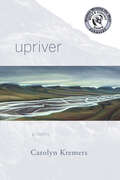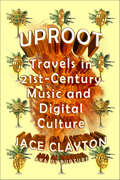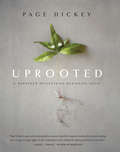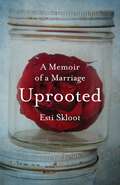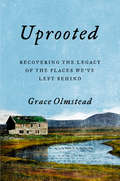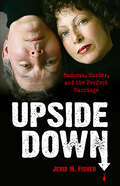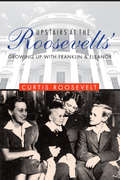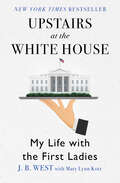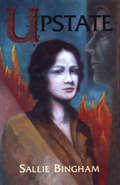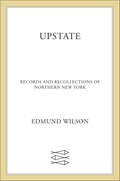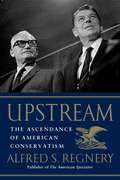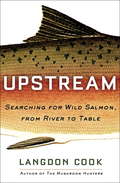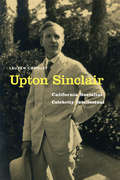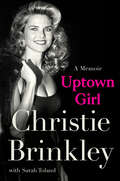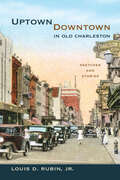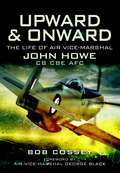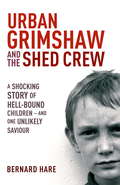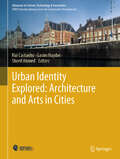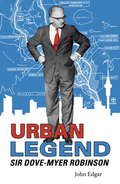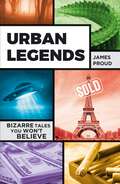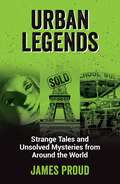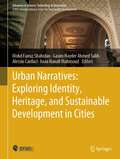- Table View
- List View
Upriver (The Alaska Literary Series)
by Carolyn KremersPoet, nonfiction writer, and lifelong musician Carolyn Kremers moved to Alaska to teach in the remote Bering Sea coast village of Tununak when she was thirty-four. Her first book, Place of the Pretend People: Gifts from a Yup’ik Eskimo Village (a memoir), probed and celebrated that experience. Upriver continues the chronicle of Kremers’ personal journey deep into Alaska and the human soul. Mixing music, Yup’ik language, the natural world, honesty, and an intimate sense of the spiritual and the unobtainable, Kremers presents a cascade of poems made of beauty and pain. The poems fall into five settings—Tununak, the Interior, Shape-Shifting, Return to the Y-K Delta, and Fairbanks. Like salmon swimming instinctively upriver—toward home—this story confronts what it means and how it feels to love a person or a place, no matter the consequences.
Uproot: Travels in 21st-Century Music and Digital Culture
by Jace Clayton“A meditation on how sounds are made, circulated and used by people around the world.” —GuardianIn 2001, Jace Clayton was an amateur DJ who recorded a three-turntable, sixty-minute mix called Gold Teeth Thief and put it online to share with his friends. Within months, the mix became an international calling card, whisking Clayton away to a sprawling, multitiered nightclub in Zagreb, a tiny gallery in Osaka, a former brothel in São Paolo, and the atrium of MoMA. And just as the music world made its fitful, uncertain transition from analog to digital, Clayton found himself on the front lines of an education in the creative upheavals of art production in the twenty-first-century globalized world.Uproot is a guided tour of this newly opened cultural space, mapped with both his own experiences and his relationships with other industry game-changers such as M.I.A. and Pirate Bay. With humor, insight, and expertise, Clayton illuminates the connections between a Congolese hotel band and the indie rock scene, Mexican surfers and Israeli techno, Japanese record collectors and hidden rain-forest treasure, and offers an unparalleled understanding of music in a digital age. Uproot takes readers behind the turntable decks to tell a story that only a DJ—and writer—of this caliber can tell.
Uprooted: A Gardener Reflects on Beginning Again
by Page Dickey"An intimate, lesson-filled story of what happens when one of America&’s best-known garden writers transplants herself, rooting in to a deeper partnership with nature than ever before." —Margaret Roach, author of A Way to Garden When Page Dickey moved away from her celebrated garden at Duck Hill, she left a landscape she had spent thirty-four years making, nurturing, and loving. She found her next chapter in northwestern Connecticut, on 17 acres of rolling fields and woodland around a former Methodist church. In Uprooted, Dickey reflects on this transition and on what it means for a gardener to start again. In these pages, follow her journey: searching for a new home, discovering the ins and outs of the landscape surrounding her new garden, establishing the garden, and learning how to be a different kind of gardener. The surprise at the heart of the book? Although Dickey was sad to leave her beloved garden, she found herself thrilled to begin a new garden in a wilder, larger landscape. Written with humor and elegance, Uprooted is an endearing story about transitions—and the satisfaction and joy that new horizons can bring.
Uprooted: Memoir
by Esti SklootWhen pregnant Esther—a young, adventurous, British-born Israeli—follows her new husband, Steve, to America, she has no idea what she&’s getting herself into. Even before their baby is born, Esther discovers the dark side of her charming film production manager husband, and learns that she must cope with his moodiness and domineering personality. Left alone day after day in a high-rise apartment in Queens, Esther struggles with culture shock, homesickness, and adapting her husband&’s whims—like the baby goat he brings home to their eighth-floor apartment to keep as a pet. Ten years and two more children later, thirty-four-year-old Steve is diagnosed with a malignant brain tumor. Despite aggressive treatments, he succumbs to the disease, leaving Esther to care for their three children alone, Esther at first feels lost and bewildered; as time goes on, however, she discovers that there is a freedom in her new situation—and that she has a greater inner strength than she ever before realized.
Uprooted: Recovering the Legacy of the Places We've Left Behind
by Grace Olmstead"A superior exploration of the consequences of the hollowing out of our agricultural heartlands."—Kirkus ReviewsIn the tradition of Wendell Berry, a young writer wrestles with what we owe the places we&’ve left behind. In the tiny farm town of Emmett, Idaho, there are two kinds of people: those who leave and those who stay. Those who leave go in search of greener pastures, better jobs, and college. Those who stay are left to contend with thinning communities, punishing government farm policy, and environmental decay. Grace Olmstead, now a journalist in Washington, DC, is one who left, and in Uprooted, she examines the heartbreaking consequences of uprooting—for Emmett, and for the greater heartland America. Part memoir, part journalistic investigation, Uprooted wrestles with the questions of what we owe the places we come from and what we are willing to sacrifice for profit and progress. As part of her own quest to decide whether or not to return to her roots, Olmstead revisits the stories of those who, like her great-grandparents and grandparents, made Emmett a strong community and her childhood idyllic. She looks at the stark realities of farming life today, identifying the government policies and big agriculture practices that make it almost impossible for such towns to survive. And she explores the ranks of Emmett&’s newcomers and what growth means for the area&’s farming tradition. Avoiding both sentimental devotion to the past and blind faith in progress, Olmstead uncovers ways modern life attacks all of our roots, both metaphorical and literal. She brings readers face to face with the damage and brain drain left in the wake of our pursuit of self-improvement, economic opportunity, and so-called growth. Ultimately, she comes to an uneasy conclusion for herself: one can cultivate habits and practices that promote rootedness wherever one may be, but: some things, once lost, cannot be recovered.
Upside Down: Madness, Murder, and the Perfect Marriage
by Jerid M. FisherTimothy Wells and Christine Sevilla's love was inspiring. Married for almost twenty years, the husband and wife passionately adored each other. Friends, family, and acquaintances all wished to have a relationship as solid as that of Tim and Christine. There was no sign that their marriage was anything less than ideal-until the day Wells brutally murdered his wife.This deep, disturbing exploration of the psyche of Timothy Wells is not a whodunit but a "whydunit." Written with Wells's cooperation, this riveting account thoroughly presents the circumstances leading up to Sevilla's murder. It features interviews and letters from the Wells and Sevilla families as well as testimony from friends, neighbors, and ex-spouses. Trapped inside his own mind, Wells' emotional insecurities left him with no escape from his severe depression and swiftly multiplying anxieties. In chilling detail, this true narrative traces the path of a man doomed by his own inner demons.
Upstairs At The White House: my life with the first ladies
by J. B. WestJ B West was Assistant usher in the white house from FDR's last term through 1969. he tells what the people who lived there were like in all phases of their time in the white house.
Upstairs at the Roosevelts': Growing Up with Franklin and Eleanor
by Curtis RooseveltCurtis Roosevelt knew what it was like to live with a president. His grandfather was Franklin Delano Roosevelt. From the time Curtis, with his sister, Eleanor, and recently divorced mother, Anna Roosevelt Dall, moved into his grandparents’ new home—the White House—Curtis played, learned, slept, ate, and lived in one of the most famous buildings in the world with one of its most famous residents. Curtis Roosevelt offers anecdotes and revelations about the lives of the president and First Lady and the many colorful personalities in this presidential family. From Eleanor’s shocking role in the remarriage of Curtis’s mother to visits from naughty cousins and trips to the “Home Farm,” Upstairs at the Roosevelts’ provides an intimate perspective on the dynamics of one of America’s most famous families and those who visited, were friends, and sometimes even enemies.
Upstairs at the White House: My Life with the First Ladies
by Mary Lynn Kotz J. B. WestIn this New York Times bestseller, the White House chief usher for nearly three decades offers a behind-the-scenes look at America&’s first families. J. B. West, chief usher of the White House, directed the operations and maintenance of 1600 Pennsylvania Avenue—and coordinated its daily life—at the request of the president and his family. He directed state functions; planned parties, weddings and funerals, gardens and playgrounds, and extensive renovations; and, with a large staff, supervised every activity in the presidential home. For twenty-eight years, first as assistant to the chief usher, then as chief usher, he witnessed national crises and triumphs, and interacted daily with six consecutive presidents and first ladies, as well as their parents, children and grandchildren, and houseguests—including friends, relatives, and heads of state. J. B. West, whom Jackie Kennedy called &“one of the most extraordinary men I have ever met,&” provides an absorbing, one-of-a-kind history of life among the first ladies. Alive with anecdotes ranging from Eleanor Roosevelt&’s fascinating political strategies to Jackie Kennedy&’s tragic loss and the personal struggles of Pat Nixon, Upstairs at the White House is a rich account of a slice of American history that usually remains behind closed doors.
Upstate
by Sallie BinghamA woman's obsession drives an affair out of control, violating social contracts and devastating the people in its path. For years, Ann and David shared weekends and holidays with country friends Flora and Edwin, even after womanizing Edwin took Ann away to pick grapes and started a year-long affair. The ground rules were clear from the start: Flora accepted what she called Edwin's meaningless "things," and Edwin stipulated no divorces. But Ann's empty marriage (to which David was providing neither money nor sex) and growing need for Edwin causes her to ask for more, leading to estrangement and a startling climax.
Upstate: Records and Recollections of Northern New York (New York Classics Ser.)
by Edmund WilsonHistorical recollections of life in upstate New York from Edmund Wilson, one of America's preeminent literary critics of the twentieth century. “What I have written . . . shows the gradual but steady expiration of the world of New York State as I knew it in my childhood and the modifications that its life has undergone. It is true that Lowville and Boonville have changed less—unless perhaps Charlottesville, Virginia—than any other part of this country that I knew when I was a child. But, as has been seen, it has reflected all the changes that, to a greater degree, have been taking place in the life of the country as a whole.” - Edmund Wilson
Upstream
by Alfred S. RegneryAlfred S. Regnery, the publisher of The American Spectator, has been a part of the American conservative movement since childhood, when his father founded The Henry Regnery Company, which subsequently became Regnery Publishing -- the preeminent conservative publishing house that, among other notable achievements, published William F. Buckley's first book, God and Man at Yale. Including many uniquely personal anecdotes and stories, Regnery himself now boldly chronicles the development of the conservative movement from 1945 to the present. The outpouring of grief at the funeral of Ronald Reagan in 2004 -- and the acknowledgment that Reagan has come to be considered one of the greatest presidents of the twentieth century -- is Regnery's opening for a fascinating insider story. Beginning at the start of the twentieth century, he shows how in the years prior to and just post World War II, expanding government power at home and the expanding Communist empire abroad inspired conservatives to band together to fight these threats. The founding of the National Review, the drive to nominate Barry Goldwater first as vice-president and later as president, the apparent defeat of the conservative movement at the hands of Lyndon Johnson, and the triumphant rise of Ronald Reagan from the ashes are all chronicled in vivid prose that shows a uniquely intimate knowledge of the key figures. Regnery shares his views on the opposition that formed in response to Earl Warren's Supreme Court rulings, the role of faith (both Roman Catholic and Evangelical) in the renewed vigor of conservatism, and the contributing role of American businessmen who attempted to oppose big government. Upstream ultimately gives perspective to how the most vibrant political and cultural force of our time has influenced American culture, politics, economics, foreign policy, and all institutions and sectors of American life.
Upstream: Searching for Wild Salmon, from River to Table
by Langdon CookFrom the award-winning author of The Mushroom Hunters comes the story of an iconic fish, perhaps the last great wild food: salmon. For some, a salmon evokes the distant wild, thrashing in the jaws of a hungry grizzly bear on TV. For others, it’s the catch of the day on a restaurant menu, or a deep red fillet at the market. For others still, it’s the jolt of adrenaline on a successful fishing trip. Our fascination with these superlative fish is as old as humanity itself. Long a source of sustenance among native peoples, salmon is now more popular than ever. Fish hatcheries and farms serve modern appetites with a domesticated “product”—while wild runs of salmon dwindle across the globe. How has this once-abundant resource reached this point, and what can we do to safeguard wild populations for future generations? Langdon Cook goes in search of the salmon in Upstream, his timely and in-depth look at how these beloved fish have nourished humankind through the ages and why their destiny is so closely tied to our own. Cook journeys up and down salmon country, from the glacial rivers of Alaska to the rainforests of the Pacific Northwest to California’s drought-stricken Central Valley and a wealth of places in between. Reporting from remote coastlines and busy city streets, he follows today’s commercial pipeline from fisherman’s net to corporate seafood vendor to boutique marketplace. At stake is nothing less than an ancient livelihood. But salmon are more than food. They are game fish, wildlife spectacle, sacred totem, and inspiration—and their fate is largely in our hands. Cook introduces us to tribal fishermen handing down an age-old tradition, sport anglers seeking adventure and a renewed connection to the wild, and scientists and activists working tirelessly to restore salmon runs. In sharing their stories, Cook covers all sides of the debate: the legacy of overfishing and industrial development; the conflicts between fishermen, environmentalists, and Native Americans; the modern proliferation of fish hatcheries and farms; and the longstanding battle lines of science versus politics, wilderness versus civilization. This firsthand account—reminiscent of the work of John McPhee and Mark Kurlansky—is filled with the keen insights and observations of the best narrative writing. Cook offers an absorbing portrait of a remarkable fish and the many obstacles it faces, while taking readers on a fast-paced fishing trip through salmon country. Upstream is an essential look at the intersection of man, food, and nature.Praise for Upstream“Passionate . . . Cook deftly conveys his love of nature, the beauty of the Pacific Northwest, and the delectable eating provided by fresh caught wild salmon.”—Library Journal “Insightful . . . this work is a great place to learn what needs to done—and an entertaining view on the positive and negative connections humans have with the natural environment.”—Publishers Weekly“Langdon Cook delivers a beautifully written portrait of the iconic salmon that blends history, biology, contentious politics, and the joy of fishing into a captivating and thought-provoking tale.”—Eric Jay Dolin, author of Brilliant Beacons“Salmon are the essence of the Pacific Northwest, and as Langdon Cook shows so powerfully, they are the key to its future."—Rowan Jacobsen, author of The Essential Oyster“In this fresh tale of an ancient wonder, Langdon Cook takes us on an inspired journey of discovery through the heart and soul of salmon country.”—David R. Montgomery, author of King of Fish and Growing a Revolution
Upton Sinclair: California Socialist, Celebrity Intellectual
by Lauren CoodleyHad Upton Sinclair not written a single book after The Jungle, he would still be famous. But Sinclair was a mere twenty-five years old when he wrote The Jungle, and over the next sixty-five years he wrote nearly eighty more books and won a Pulitzer Prize for fiction. He was also a filmmaker, labor activist, women&’s rights advocate, and health pioneer on a grand scale. This new biography of Sinclair underscores his place in the American story as a social, political, and cultural force, a man who more than any other disrupted and documented his era in the name of social justice.Upton Sinclair: California Socialist, Celebrity Intellectual shows us Sinclair engaged in one cause after another, some surprisingly relevant today—the Sacco-Vanzetti trial, the depredations of the oil industry, the wrongful imprisonment of the Wobblies, and the perils of unchecked capitalism and concentrated media. Throughout, Lauren Coodley provides a new perspective for looking at Sinclair&’s prodigiously productive life. Coodley&’s book reveals a consistent streak of feminism, both in Sinclair&’s relationships with women—wives, friends, and activists—and in his interest in issues of housework and childcare, temperance and diet. This biography will forever alter our picture of this complicated, unconventional, often controversial man whose whole life was dedicated to helping people understand how society was run, by whom, and for whom.
Uptown Girl: A Memoir
by Christie BrinkleyIn 1974, a twenty-year-old Christie Brinkley was “discovered” outside a Paris phone booth, which set off a meteoric modeling career that would land her on the covers of hundreds of magazines and cement her legacy as an All-American icon. <p> Although she’s lived more than fifty years in the public eye, the full story of her roller-coaster life has never been told. Now, for the first time, Christie shares what life has been like, both in front of and behind the cameras, considering the girl she was alongside the woman she has become. Her stories are as heartening as they are eye-opening, as she recounts her most formative chapters, including the betrayal by her biological father as a child, her lifelong passion for art, her whirlwind career, her four tumultuous marriages—including her heartbreaking divorce from Billy Joel—and the harrowing experiences that almost cut her life short. <p> Through it all, Christie’s unwavering belief in the magic and mystery of life has been her guiding light, even during her darkest times. It is with this grace and gratitude that she tenderly chronicles the unexpected, unexplainable ways her life has unfolded, embracing every adventure and twist of fate along the way: traveling the world as a supermodel at the height of the model wars, living life on the road with her rock-star husband and their baby, starring in blockbuster movies and hit sitcoms, riding horses with cowboys, training with world-champion boxers, and even stepping into the spotlight on Broadway. <p> A bighearted, beautifully crafted memoir of resilience and self-discovery, featuring more than 100 photographs and never-before-seen pieces of Christie’s original artwork, Uptown Girl is the brave account of a life lived at full throttle and on full display. <b>New York Times Bestseller</b>
Uptown/Downtown in Old Charleston: Sketches and Stories
by Louis D. Rubin Jr.A series of semi-autobiographical sketches and stories detailing life in Charleston, South Carolina, in the 1930s and ‘40s.Growing up in Charleston in the 1930s and 1940s, accomplished storyteller Louis Rubin witnessed the subtle gradations of caste and class among neighborhoods, from south of Broad Street where established families and traditional mores held sway, to the various enclaves of Uptown, in which middle-class and blue-collar families went about their own diverse lives and routines. In Uptown/Downtown in Old Charleston, Rubin draws on autobiography and imagination in briskly paced renderings of his native Charleston that capture the atmosphere of the Holy City during an era when the population had not yet swelled above sixty-five thousand. Rubin’s wide-eyed narrator takes readers on excursions to Adger’s Wharf, the Battery, Union Terminal, the shops of King Street, the Majestic Theater, the College of Charleston, and other recognizable landmarks. With youthful glee he watches the barges and shrimp trawlers along the waterfront, rides streetcars down Rutledge Avenue and trains to Savannah and Richmond, paddles the Ashley River in a leaky homemade boat, pitches left-handed for the youngest team in the Twilight Baseball League, ponders the curious chanting coming from the Jewish Community Center, and catches magical glimpses of the Morris Island lighthouse from atop the Folly Beach Ferris wheel. His fascination with the gas-electric Boll Weevil train epitomizes his appreciation for the freedom of movement between the worlds of Uptown and Downtown that defines his youth in Charleston.This collection ends with a homecoming to Charleston by our narrator, then a young man in his early twenties, as his inbound train is greeted by familiar vistas of the city as well as by views he had never encountered before. This is the city Rubin called home, where there were always surprising discoveries to be found both in the burgeoning newness of Uptown and the storied legacies of Downtown.“Uptown/Downtown in Old Charleston is about a city in some ways larger that the state in which it resides. The book is also about memory and boyhood and baseball and boats and trains and family—and it packs a great wallop because it’s written by one of the country’s finest writers. These nine stories are among the best nine innings of history you’ll ever read.” —Clyde Edgerton“Louis Rubin brings the city to life with his insider guide to a secret Charleston too often overlooked in the carriage tours and guidebooks of today. Rubin allows you to enter the soul of the real Charleston, revealing its essence and depth. A wonderful, necessary book.” —Pat Conroy, author of South of Broad
Upward & Onward: The Life of Air Vice-Marshal John Howe CB CBE AFC
by Bob CosseyJohn Howe started his flying career in the postwar South African Air Force, learning to fly on Tiger Moths, Harvards and Spitfires. He was posted to No 2 Squadron SAAF and sent to Korea to fly with South Africas contribution to the war in support of the UN forces. There he flew the Mustang F-51D fighter-bombers in front-line action during his first tour. A second tour saw him with the US Infantry as a Forward Air Controller operating on the ground. As the political situation in South Africa became more extreme he resigned from the SAAF and came to England where he was asked by the RAF to fly their first jet fighters and later instruct on Vampires, converting later to the Hunter and joined 222 Squadron at Leuchars. During the Suez crisis he again operated as a Forward Ground Controller and landed on the beaches with 40 Commando. He was appointed CO of 74 Tiger Squadron to introduce the supersonic Lightning into service with the RAF. Traveling extensively, demonstrating the remarkable capabilities of the new fighter. His late career took him to Fighter Commands HQ, RAF Staff College and the Joint Warfare School. After a posting to the USA on an exchange tour flying most of the Century Series Fighters and the Phantom he returned to the UK to head up 228 OCU to introduce the Phantom FGR2 into operational service. Towards the end of his 44 year service career he commanded the RAF base at Gutersloh on the front line of the Iron Curtain flying and his final posting was Commandant of the RAF Regiment
Urban Grimshaw and The Shed Crew
by Bernard HareYou're twelve years old. Your mother's a junkie and your father might as well be dead. You can't read or write, and you don't go to school. An average day means sitting round a bonfire with your mates smoking drugs, or stealing cars. Welcome to Urban's world. Bernard Hare was on society's margins, living on one of Leeds' roughest estates and with a liking for drink and drugs. So he knew what life in the underclass was like in '90s Britain. But even he was shocked when he met Urban, an illiterate, glue-sniffing twelve-year-old. And through Urban he got to know the Shed Crew - an anarchic gang of kids between the ages of ten and fourteen; joy-riding, thieving runaways, who were no strangers to drugs or sex. Nearly all had been in care, but few adults really cared. Bernard decided to do what he could. He didn't know what he was letting himself in for.
Urban Grimshaw and The Shed Crew
by Bernard HareYou're twelve years old. Your mother's a junkie and your father might as well be dead. You can't read or write, and you don't go to school. An average day means sitting round a bonfire with your mates smoking drugs, or stealing cars. Welcome to Urban's world. Bernard Hare was on society's margins, living on one of Leeds' roughest estates and with a liking for drink and drugs. So he knew what life in the underclass was like in '90s Britain. But even he was shocked when he met Urban, an illiterate, glue-sniffing twelve-year-old. And through Urban he got to know the Shed Crew - an anarchic gang of kids between the ages of ten and fourteen; joy-riding, thieving runaways, who were no strangers to drugs or sex. Nearly all had been in care, but few adults really cared. Bernard decided to do what he could. He didn't know what he was letting himself in for.
Urban Identity Explored: Architecture and Arts in Cities (Advances in Science, Technology & Innovation)
by Gasim Hayder Rui Castanho Sherif AhmedThis book systematically examines historical perspectives, meticulously unveiling the nuanced narratives embedded within cityscapes across epochs, providing a comprehensive chronicle of architectural evolution. It conducts a thorough exploration of cultural heritage and transformation, illuminating the dynamic interplay of diverse traditions that breathe vitality into urban landscapes, shaping their unique character. The discourse navigates the intricate terrain of urban sustainability and fragility, meticulously analyzing the delicate equilibrium required to preserve historical integrity while embracing sustainable urban development imperatives. Diverse perspectives on architectural heritage are thoughtfully presented, amplifying the voices often marginalized, and contributing to a more inclusive understanding of our shared history.
Urban Legend - Sir Dove-Myer Robinson: Sir Dove-myer Robinson
by John EdgarEvery Aucklander of a certain age knows that we should have listened to Mayor Robbie back in the 1970s' - Labour Party MP Phil Twyford. But who was he? And why is he still relevant today? From a working class Jewish boy in Sheffield to long serving Mayor of Auckland (1959-1980), Sir Dove-Myer Robinson's life followed an unusual path. A slight, bespectacled man whose tiny stature was offset by a booming voice and massive ego, he was a natural political campaigner. Associated with a host of local and national causes, he became Auckland's most recognisable spokesperson. He joined political causes and challenged convention. He fought for our current waste water treatment process, against French nuclear testing, and an integrated Auckland transport system and city. Though his political career was outstanding and memorable, his personal life was a hot bed of gossip. Four wives, one 20 years his junior, and a very public divorce during one of his terms meant he was never far from the headlines. In this book we look at both his personal life and his outstanding political career, which affected not only the future of Auckland, but the future of New Zealand.
Urban Legends: Bizarre Tales You Won't Believe
by James ProudThere are some stories that people claim without a doubt are true. ‘It really happened, to a friend of a friend!’ Who knows if they have credibility or if they’re the products of ‘Chinese Whispers’ and vivid imaginations? Whatever the case, this collection of creepy tales has the power to unnerve and fascinate us all.
Urban Legends: Strange Tales and Unsolved Mysteries from Around the World
by James ProudStrange happenings, unsolved mysteries and seemingly supernatural events have gripped us for centuries. Whether they’re based on a grain of truth or a flight of fancy, the myths, legends and weird tales contained within this book will take you on a fascinating journey to the outer limits of plausibility, and dare you to believe the unbelievable.
Urban Narratives: Exploring Identity, Heritage, and Sustainable Development in Cities (Advances in Science, Technology & Innovation)
by Gasim Hayder Ahmed Salih Mohd Fairuz Shahidan Alessio Cardaci Israa Hanafi MahmoudThis book engages readers in an enlightening exploration of cities' identities, sustainability, and urban development. Delving into the intricate interplay between art, architecture, and the urban landscape, it offers a compelling analysis of the factors that shape cities and their distinct personalities. The volume uncovers captivating stories of cities as they navigate the delicate balance between heritage conservation and modernity. It highlights innovative strategies employed to preserve historical sites while adapting to the demands of a rapidly changing world. Full of insightful discussions on the impact of cultural lifestyles, the fusion of architectural styles, and the challenges and triumphs of sustainable urban development, it draws upon a diverse range of perspectives and research, inviting architects, urban planners, and scholars to delve into the intricate nuances of cities' identities in the process.With its informative and engaging narrative, this book providesa fresh perspective on cities' identities and offers practical insights into shaping vibrant, livable urban landscapes.
